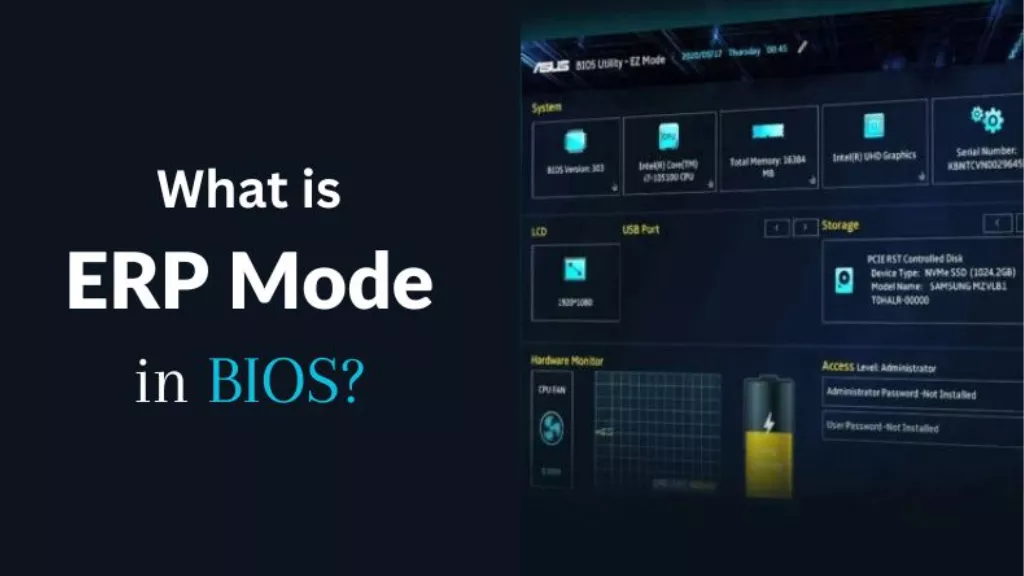
In the world of computer hardware and technology, acronyms often take center stage, and one such term you might come across is “ERP-Ready” in BIOS.
BIOS, which stands for Basic Input/output System, is a critical component of a computer’s hardware that bridges the gap between the operating system and the hardware. Within the BIOS settings, you might encounter the term “ERP-Ready,” and this article aims to explain it what it means, why it matters, and how it can impact your computing experience.
Understanding ERP-Ready Mean in Bios.
“ERP” stands for Energy-Related Products, and the term is associated with regulations and directives developed by the European Union (EU) to promote energy efficiency and reduce the environmental impact of electronic devices. ERP regulations cover a wide range of products, including computers, monitors, televisions, and more. The goal is to ensure that products sold within the EU meet specific energy consumption and efficiency standards.
In the context of BIOS, “ERP-Ready” refers to a feature or setting that complies with the energy efficiency requirements outlined by the ERP regulations. When a computer’s BIOS is ERP-Ready, it means that the system is designed to operate in a more power-efficient manner, reducing energy consumption and environmental impact.
Key Aspects of ERP-Ready BIOS
Low-Power States:
An ERP-Ready BIOS often includes support for low-power states, such as Sleep and Hibernate modes. These states allow the computer to consume significantly less power when it’s not actively in use. For instance, when you put your computer to sleep, it enters a low-power state where only essential components are active.
Wake-On Features:
Wake-On-LAN (WoL) and Wake-On-USB are features commonly associated with ERP-Ready BIOS. These features enable a computer to “wake up” from a low-power state when it receives a specific signal, such as a network packet or a USB device connection. This allows for remote management and reduces the need to keep the computer running constantly.
Power Management Settings:
An ERP-Ready BIOS provides comprehensive power management settings that allow users to customize how the system uses energy. These settings might include adjusting CPU performance, screen brightness, and setting time intervals for system sleep or shutdown.
Energy-Efficient Hardware Configuration:
In an ERP-Ready system, the BIOS might also control certain hardware components to optimize their power consumption. For instance, it could regulate fan speeds, hard drive spin-down times, and even limit the power supplied to USB ports when they’re not in use.
Benefits of ERP-Ready BIOS
Energy Savings:
The primary benefit of an ERP-Ready BIOS is reduced energy consumption. By efficiently managing power states and components, the system uses less energy during periods of inactivity or when certain components are idle.
Extended Hardware Lifespan:
Lower power consumption often leads to less heat generation, which can contribute to the extended lifespan of hardware components. Computers that run cooler due to efficient power management are less likely to experience thermal stress, which can impact component longevity.
Environmental Impact:
Embracing ERP-Ready BIOS contributes to the broader goal of reducing the environmental impact of technology. Energy-efficient systems help lower greenhouse gas emissions and reduce the strain on power grids.
Energy Cost Savings:
For individuals and organizations, ERP-Ready BIOS can lead to cost savings on energy bills. As computers consume less power when not in use, the overall energy expenditure decreases.
Compliance:
For those operating within the European Union or aiming to adhere to ERP regulations, an ERP-Ready BIOS ensures compliance with energy efficiency standards.
Enabling ERP-Ready Mode
Enabling ERP-Ready mode in BIOS settings can vary based on the computer’s manufacturer and model. However, the general process involves the following steps:
- Access BIOS Settings: Restart your computer and enter the BIOS setup. This is typically done by pressing a specific key (e.g., F2, Delete, F12) during the boot process. Check your computer’s documentation for the correct key.
- Navigate to Power Management: Within the BIOS settings, locate the section related to power management or energy-saving features. This is where you’ll find the ERP-related settings.
- Enable ERP-Ready: Look for an option related to ERP-Ready or energy-efficient modes. Enable this option to activate the energy-saving features associated with ERP compliance.
- Save and Exit: After making changes, save your BIOS settings and exit. The changes will take effect the next time you boot up your computer.
Conclusion
In a world increasingly focused on energy efficiency and environmental responsibility, the concept of ERP-Ready BIOS holds significant importance. This feature allows computers to operate in a power-efficient manner, reducing energy consumption during periods of inactivity and optimizing hardware performance. By embracing ERP-Ready settings, users benefit from cost savings, extended hardware lifespans, and a reduced carbon footprint.
As technology continues to evolve, ERP-Ready BIOS serves as a testament to the industry’s commitment to balancing performance with environmental considerations. Whether you’re a casual user or a business professional, understanding and enabling ERP-Ready mode in your BIOS can make a tangible difference in energy efficiency and sustainability.
Related Articles:
